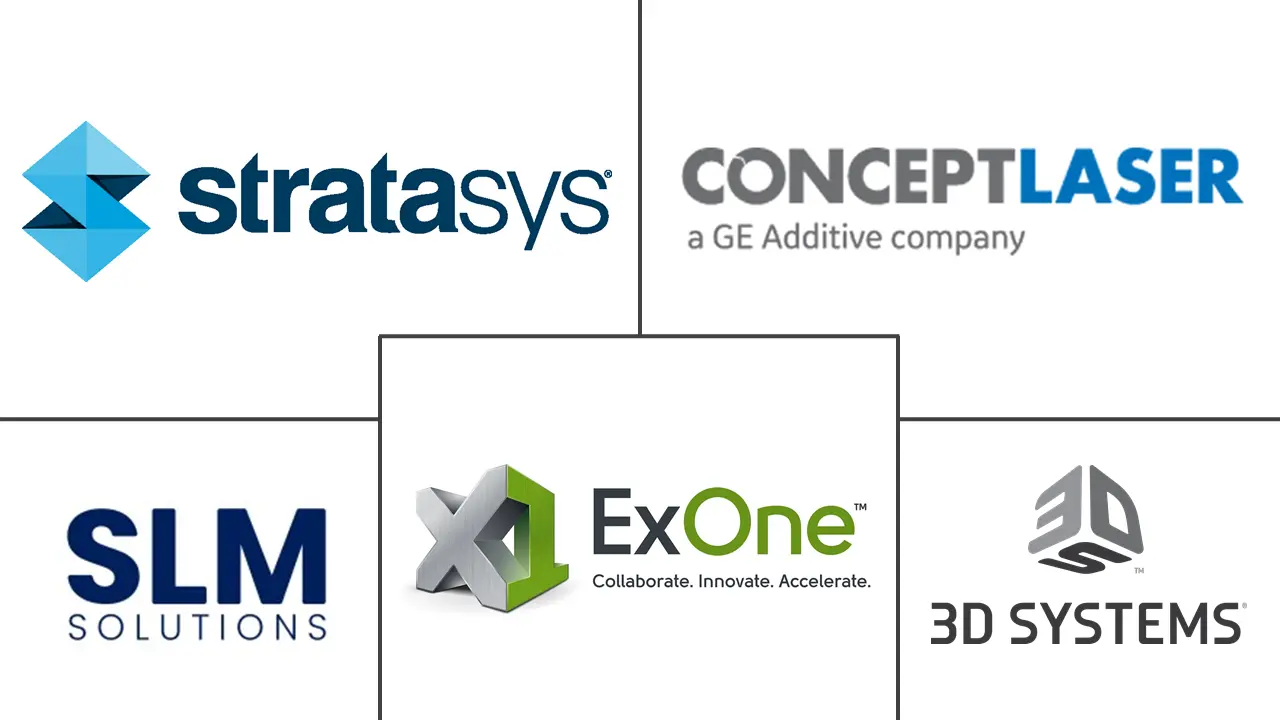Automated 3D Printing Market Size and Share
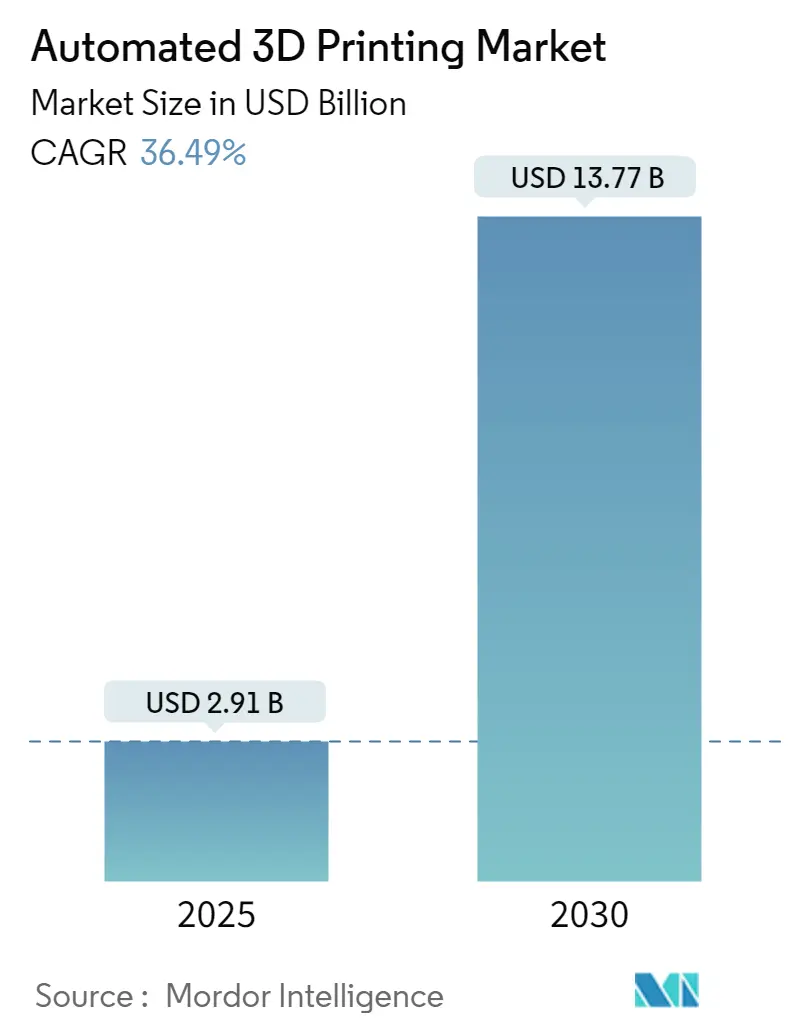
Automated 3D Printing Market Analysis by Mordor Intelligence
The Automated 3D Printing Market size is estimated at USD 2.91 billion in 2025, and is expected to reach USD 13.77 billion by 2030, at a CAGR of 36.49% during the forecast period (2025-2030).
The automated 3D printing industry is experiencing a transformative shift as manufacturers increasingly integrate Industry 4.0 technologies into their production processes. Advanced machine learning algorithms and artificial intelligence are revolutionizing material development and optimization processes, enabling manufacturers to discover and formulate new printing materials with enhanced performance characteristics. This technological convergence has led to the development of sophisticated platforms that can automatically optimize material properties such as toughness and compression strength, significantly reducing the time and resources required for material development. The integration of these smart technologies has particularly benefited the automotive sector, where, according to industry projections, global light vehicle production is expected to reach 93 million units by 2025.
Post-processing automation has emerged as a critical focus area for industry innovation, with manufacturers developing increasingly sophisticated solutions for support removal, surface finishing, and quality control. Companies are implementing end-to-end automated manufacturing workflows that incorporate advanced post-processing stations, automated material handling systems, and quality control mechanisms. These developments are particularly significant in the context of mass customization and high-volume production, where manual post-processing has traditionally been a major bottleneck. The automotive industry exemplifies this trend, with the global vehicle fleet expected to grow from the current 1.3 billion to approximately 1.8 billion by 2035, driving demand for industrial automation solutions.
The market is witnessing significant advancement in material science and sustainability initiatives, with a growing emphasis on recycled and eco-friendly printing materials. Manufacturers are developing automated systems capable of processing a wider range of materials, including high-performance polymers, metals, and composites. This evolution in material processing capabilities has enabled the production of more complex and functional parts, expanding the application scope of automated 3D printing across industries. The integration of automated material handling and recycling systems has also contributed to improved resource efficiency and reduced waste in the production process.
Cross-industry adoption of industrial 3D printing solutions continues to expand, with particularly strong growth in the aerospace, healthcare, and consumer products sectors. Recent innovations include the development of automated platforms capable of handling multiple materials and processes simultaneously, enabling more efficient and versatile production capabilities. For instance, Mosaic's Array platform, launched in 2023, demonstrates the industry's move toward fully automated production systems with features like automated material handling, print removal, and storage capabilities. Similarly, the integration of Raspberry Pi-based automation systems in desktop 3D printers highlights the increasing accessibility of automation technologies across different market segments, contributing to the evolution of the smart factory concept.
Global Automated 3D Printing Market Trends and Insights
Increasing Investments in R&D
The automated 3D printing industry is witnessing substantial research and development investments across multiple sectors, with companies focusing on developing innovative applications and improving existing technologies. Major automotive manufacturers are leading this trend, with companies like Volkswagen partnering with Siemens and HP to industrialize 3D printing of structural parts that are significantly lighter than traditional sheet steel components. These investments are driving innovations in materials and processes, as demonstrated by UK-based Equipmake's development of a power-dense permanent magnet electric motor in collaboration with 3D printing specialist Hieta, achieving a remarkable power-to-weight ratio of 295bhp in a 10kg motor.
The construction and infrastructure sectors are also witnessing significant R&D investments, particularly in automated concrete 3D printing technologies. Research institutions and companies are developing novel approaches to reduce concrete usage while maintaining structural integrity. For instance, researchers have successfully developed cementitious mix compositions suitable for 3D printing, utilizing industrial waste as binders to manufacture urban furniture. This innovation has demonstrated the potential to decrease concrete usage by up to 75% while creating durable, functional structures. Additionally, companies like Largix have invested in developing the first 3D printer capable of producing large industrial storage tanks from common and recycled polymers, incorporating smart sensors with real-time data and machine learning capabilities to ensure optimal bonding and welding strengths.
Growth in Adoption of Robotics for Industrial Automation
The integration of robotics in automated 3D printing is experiencing rapid growth, driven by the need for increased precision, efficiency, and scalability in manufacturing processes. According to the International Federation of Robotics, the operational stock of multipurpose industrial robots reached approximately 3 million units globally, with the electrical/electronic industry installing around 109,000 units of industrial robots worldwide, making it the industry with the highest industrial robot installations. This trend is particularly evident in the automotive sector, where up to 90% of initial prototype assemblies in major US auto manufacturers are now 3D printed with increasing integration of industrial automation.
The adoption of robotics in 3D printing with robotics is revolutionizing traditional manufacturing processes by enabling more complex and precise operations. For instance, Virids3D's Robotic Additive Manufacturing system, which uses ABB's industrial robotic arm with an inkjet head, demonstrates the advanced capabilities in automated material deposition and precision control. Companies are increasingly implementing closed-loop control systems with AI integration, as exemplified by GE's Niskayuna Additive Research Lab's development of a machine-learning platform that uses high-resolution cameras to monitor the printing process and detect defects in real-time. This integration of robotics and AI is enabling manufacturers to achieve higher quality standards while significantly reducing production time and costs, particularly in industries requiring high-precision components such as aerospace and automotive manufacturing. The trend towards automated manufacturing and factory automation is further propelled by the need for efficient automated production systems that can adapt to the demands of digital manufacturing.
Segment Analysis: By Offering
Hardware Segment in Automated 3D Printing Market
The Hardware segment dominates the automated 3D printing market, commanding approximately 49% of the total market share in 2024. This significant market position is driven by the increasing adoption of automated 3D printing hardware solutions across various industries, particularly in the manufacturing and automotive sectors. The segment encompasses critical components such as heated beds, enclosures, dual extruders, and sophisticated industrial-grade systems that are essential for professional applications. Hardware manufacturers are focusing on making systems more productive and reliable while maintaining a compact format, which has been crucial in maintaining market leadership. The emergence of electronic 3D printing has also contributed to the segment's dominance, with companies like Nano Dimension and Optomec providing specialized hardware for electronics 3D printing, including systems for prototype and direct manufacture of electronic components such as antennas, PCBs, capacitors, and sensors.
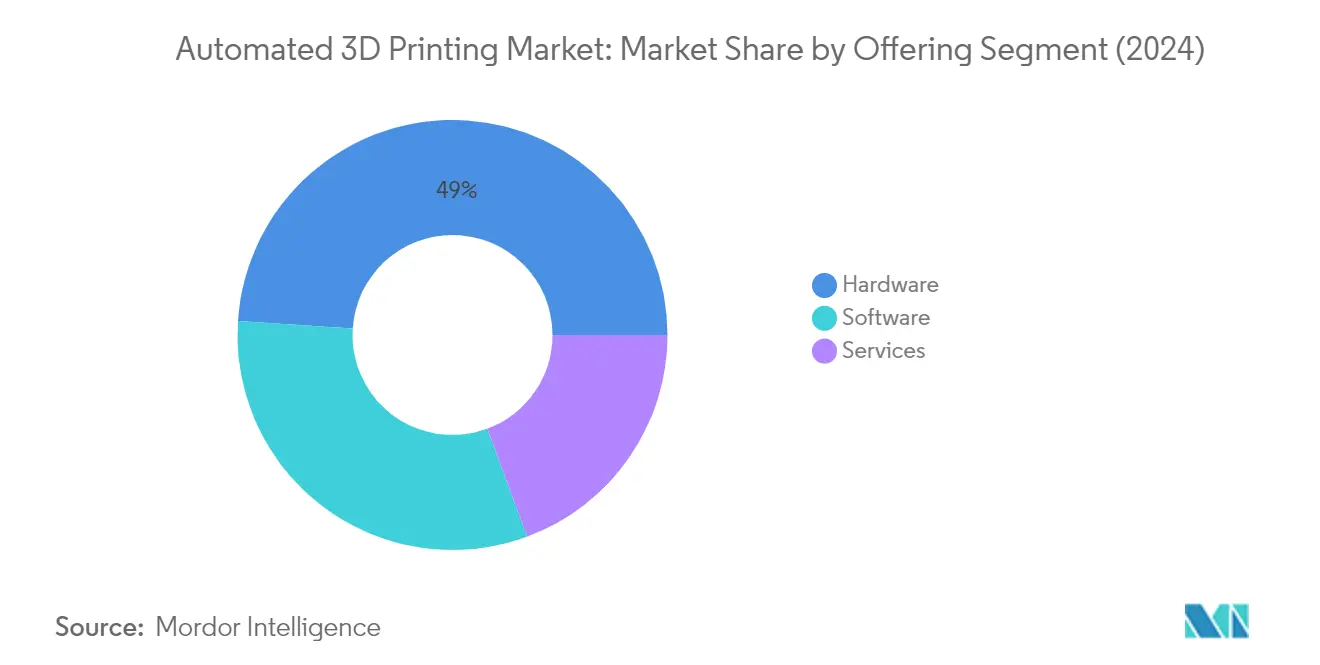
Software Segment in Automated 3D Printing Market
The Software segment is experiencing the most rapid growth in the automated 3D printing market, with a projected growth rate of approximately 45% during the forecast period 2024-2029. This exceptional growth is driven by the increasing need to overcome various challenges in the 3D printing workflow and enable complex designs to be created faster while increasing print success rates. Software solutions are becoming increasingly sophisticated, incorporating features for complicated designs, quality assurance, and workflow management. The integration of AI-powered management software, cloud-based solutions, and advanced control systems is revolutionizing the way 3D printing operations are managed. These solutions are enabling automated production control, enhanced part quality, and improved manufacturing efficiency, making them indispensable for scaling up additive manufacturing operations.
Remaining Segments in Automated 3D Printing Market by Offering
The Services segment plays a vital role in the automated 3D printing ecosystem, providing essential support functions that complement both hardware and software offerings. This segment encompasses a wide range of services including maintenance, training, consulting, and post-processing services. Service providers are increasingly focusing on offering comprehensive solutions that help organizations implement and optimize their automated 3D printing operations. The segment is particularly crucial for companies that are new to automated 3D printing technology, as it provides the necessary expertise and support for successful implementation. Service bureaus represent a significant part of this segment, offering specialized capabilities and expertise that help organizations maximize their investment in automated 3D printing technology.
Segment Analysis: By Process
Automated Production Segment in Automated 3D Printing Market
The automated production segment has emerged as the dominant force in the automated 3D printing market, commanding approximately 27% of the market share in 2024. This segment's leadership position is driven by the increasing shift from prototyping and small-batch manufacturing to mass customizable digital manufacturing technology. The integration of end-to-end workflows, digital warehouses, and digital twins has significantly enhanced the automation capabilities in production processes. Manufacturing execution software (MES) is playing a crucial role by bringing together and organizing 3D printer networks and workflow stations, while also facilitating the merger of designs with automated material supply lines for various materials including powders, pastes, resins, and fibers.
Multiprocessing Segment in Automated 3D Printing Market
The Multiprocessing segment is experiencing remarkable growth and is projected to expand at approximately 45% during the forecast period 2024-2029. This exceptional growth is attributed to the segment's ability to enable the creation of complex geometric shapes that can be mass-customized without requiring dies or molds. The additively layered technique allows multiple components to be merged into a single piece, eliminating subsequent assembly processes. The advancement of printers is enabling the production of arbitrarily shaped end-use devices, leading to direct and distributed manufacturing of items ranging from healthcare equipment to satellites.
Remaining Segments in Process Segmentation
The other significant segments in the automated 3D printing market include Material Handling, Part Handling, and Post-processing, each serving crucial functions in the overall automated 3D printing ecosystem. Material Handling focuses on the automated management and delivery of printing materials, while Part Handling specializes in the automated manipulation and positioning of printed components. The Post-processing segment addresses the critical final stages of production, including surface finishing and quality control. These segments collectively contribute to creating a comprehensive automated manufacturing solution, enabling seamless integration of various processes from initial material preparation to final product completion.
Segment Analysis: By End-User Vertical
Industrial Manufacturing Segment in Automated 3D Printing Market
Industrial Manufacturing has emerged as the dominant segment in the automated 3D printing market, commanding approximately 22% of the market share in 2024. This segment's leadership position is driven by the increasing adoption of 3D printing technologies in manufacturing processes, particularly for prototyping and production-oriented applications. Manufacturers are leveraging automated fabrication solutions to enhance operational efficiency, reduce labor costs, and implement energy-saving strategies. The integration of international standards on environmental management systems, notably the ISO 50001 standard, has significantly influenced manufacturers to invest in automated 3D printing technologies. Quality monitoring capabilities, combined with freeform manufacturing using multi-axis robotic arms, have enabled manufacturers to create complex geometries while better managing raw materials, contributing to this segment's market dominance.
Aerospace and Defense Segment in Automated 3D Printing Market
The Aerospace and Defense sector is experiencing the fastest growth in the automated 3D printing market, with a projected growth rate of approximately 44% during the forecast period 2024-2029. This remarkable growth is attributed to the sector's increasing adoption of metal additive manufacturing for critical components and spare parts production. The ability to produce lightweight, complex geometries while maintaining high precision and quality standards has made automated 3D printing particularly attractive to aerospace manufacturers. The technology's capability to reduce component weight by 50-80%, resulting in significant fuel savings, has driven its adoption across various applications, from aircraft interiors to engine components. The integration of blockchain technology and enhanced cybersecurity measures for protecting sensitive design data has further accelerated the adoption of automated 3D printing in defense applications.
Remaining Segments in End-User Vertical
The automotive sector continues to be a significant contributor to the automated 3D printing market, particularly in manufacturing tools, jigs, and fixtures, while the consumer products segment is gaining traction in applications ranging from sporting equipment to customized consumer goods. The healthcare sector is leveraging smart 3D printing for medical devices, prosthetics, and dental applications, while the energy sector is utilizing the technology for producing components in renewable energy systems and power generation equipment. Each of these segments brings unique requirements and applications to the market, driving innovation in materials, processes, and automation capabilities. The diversity of applications across these segments has led to the development of more versatile and specialized automated 3D printing solutions, contributing to the overall market growth.
Automated 3D Printing Market Geography Segment Analysis
Automated 3D Printing Market in North America
North America represents the largest automated 3D printing market globally, holding approximately 33% market share in 2024. The region's dominance is primarily driven by the strong presence of major industry players and advanced manufacturing facilities, particularly in the United States. The market benefits from extensive research and development activities in additive manufacturing technologies, with numerous universities and research institutions actively contributing to technological advancement. The region's manufacturing sector has shown particular interest in industrial automation and automated 3D printing solutions for improving operational efficiency and reducing labor costs. The automotive and aerospace industries remain key adopters, leveraging the technology for both prototyping and production applications. The integration of artificial intelligence and machine learning with automated 3D printing systems has become increasingly prevalent across the region, enabling more sophisticated and efficient manufacturing processes. Additionally, the healthcare sector has emerged as a significant growth driver, particularly in applications such as medical device manufacturing and customized implants.
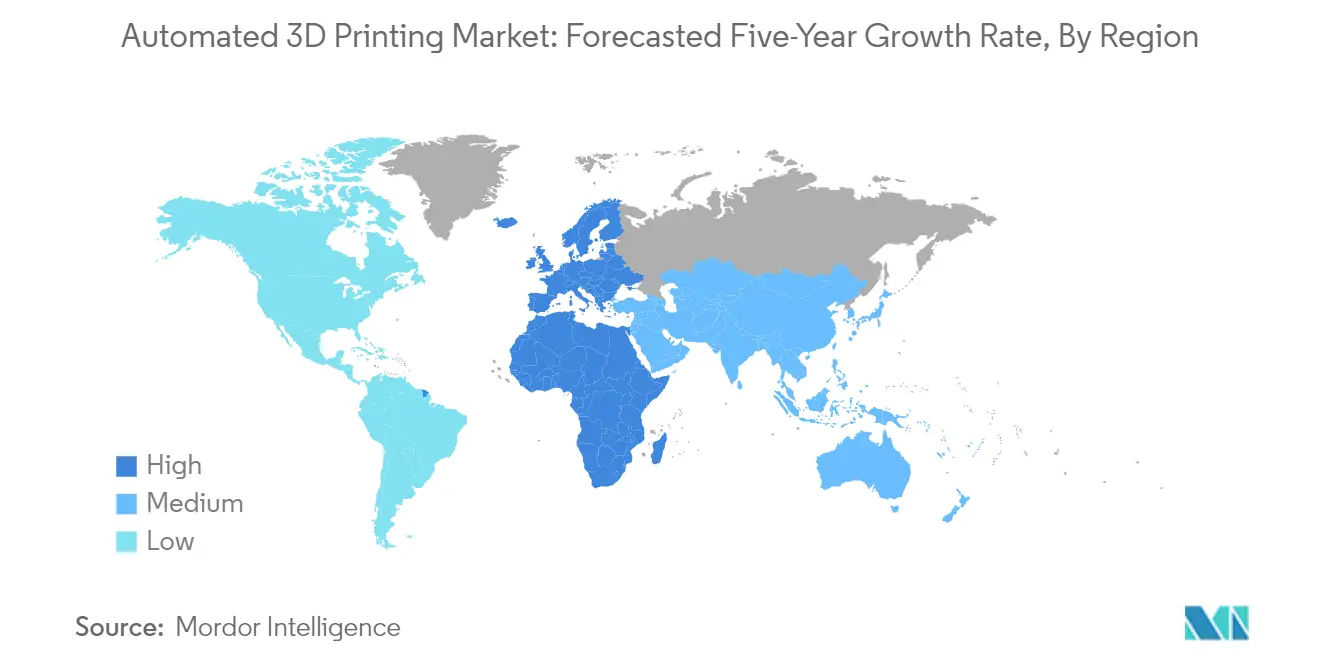
Automated 3D Printing Market in Europe
Europe has established itself as a crucial automated 3D printing market, demonstrating remarkable growth with approximately 43% CAGR from 2019 to 2024. The region's market is characterized by strong industrial automation adoption, particularly in countries like Germany, the United Kingdom, and France. European manufacturers have been at the forefront of implementing Industry 4.0 principles, integrating automated 3D printing solutions into their production workflows. The region's automotive sector has been particularly progressive in adopting these technologies, with major automotive manufacturers implementing automated 3D printing for both prototyping and production parts. The presence of numerous research institutions and technology centers has fostered continuous innovation in the field. European companies have shown particular interest in sustainable manufacturing practices, with automated 3D printing being viewed as a key enabler of reduced waste and more efficient production processes. The region's strong focus on quality standards and certification processes has helped establish reliable frameworks for automated 3D printing implementation.
Automated 3D Printing Market in Asia-Pacific
The Asia-Pacific region represents one of the fastest-growing automated 3D printing markets, with projections indicating a robust growth rate of approximately 43% from 2024 to 2029. The region's market is driven by rapid industrialization and increasing adoption of advanced manufacturing technologies, particularly in countries like China, Japan, and South Korea. Manufacturing hubs across the region are increasingly integrating automated 3D printing solutions to enhance their production capabilities and maintain competitive advantages. The electronics manufacturing sector has emerged as a key adopter of this technology, particularly in countries with strong electronics manufacturing bases. Government initiatives supporting industrial automation and Industry 4.0 adoption have created favorable conditions for market growth. The region's large manufacturing workforce is gradually transitioning towards more automated solutions, with companies investing in upskilling programs to manage advanced 3D printing systems. Rising labor costs in traditionally manufacturing-intensive countries have accelerated the adoption of automation solutions.
Automated 3D Printing Market in Latin America
Latin America's automated 3D printing market is experiencing steady growth, driven by increasing industrialization and modernization efforts across key economies like Brazil and Mexico. The region's manufacturing sector is gradually embracing automation technologies to enhance competitiveness and production efficiency. Local manufacturers are particularly interested in automated 3D printing solutions that can help reduce operational costs and improve product quality. The automotive and aerospace sectors have emerged as early adopters of this technology, particularly in countries with established manufacturing bases. Educational institutions across the region are increasingly incorporating 3D printing technologies into their curricula, helping build a skilled workforce for the future. The market is characterized by growing awareness of Industry 4.0 technologies and their potential benefits. Regional governments are implementing policies to support technological advancement in manufacturing, creating opportunities for automated 3D printing adoption.
Automated 3D Printing Market in Middle East & Africa
The Middle East and Africa region presents emerging opportunities for the automated 3D printing market, with growing adoption across various industrial sectors. The region's oil and gas industry has shown particular interest in automated 3D printing solutions for producing spare parts and specialized equipment. Countries in the Gulf Cooperation Council (GCC) are leading the adoption of advanced manufacturing technologies as part of their economic diversification initiatives. The construction sector in the region has begun exploring automated 3D printing for building components and structures. Educational institutions and research centers are increasingly focusing on developing expertise in additive manufacturing technologies. The healthcare sector is gradually adopting automated 3D printing solutions for medical device manufacturing and customized medical solutions. The region's manufacturing sector is showing growing interest in automation technologies to reduce dependence on manual labor and improve production efficiency.
Competitive Landscape
Top Companies in Automated 3D Printing Market
The automated 3D printing market features prominent players like Stratasys, GE Additive, ExOne, SLM Solutions, 3D Systems, Universal Robots, and ABB, who are driving innovation through continuous product development and strategic partnerships. These companies are focusing on enhancing their automation capabilities through advanced software integration, robotics implementation, and the development of end-to-end workflow solutions. The industry has witnessed significant investment in research and development, particularly in areas of machine learning, post-processing developments, and material science. Companies are increasingly emphasizing the development of open-architecture platforms that enable seamless integration with existing manufacturing systems and third-party solutions. Strategic collaborations with technology providers, research institutions, and end-users have become crucial for expanding market presence and technological capabilities. Market leaders are also prioritizing the development of comprehensive service networks and customer support infrastructure to ensure the successful implementation of automated 3D printing solutions across various industries.
Market Consolidation Drives Industry Evolution Forward
The automated 3D printing market exhibits a complex competitive structure with a mix of large industrial conglomerates and specialized technology providers. Global players like GE Additive and ABB leverage their extensive manufacturing expertise and worldwide presence to offer integrated solutions, while specialized firms like Formlabs and PostProcess Technologies focus on developing niche technologies and applications. The market has witnessed significant consolidation through strategic acquisitions, such as Desktop Metal's acquisition of ExOne and EnvisionTEC, demonstrating the industry's trend toward creating comprehensive solution portfolios. Companies are increasingly focusing on vertical integration to control key aspects of the value chain, from software development to material manufacturing and post-processing solutions.
The competitive landscape is characterized by a strong emphasis on intellectual property protection and technological differentiation. Market players are actively expanding their patent portfolios and developing proprietary technologies to maintain competitive advantages. The industry has seen the emergence of strategic partnerships between hardware manufacturers, software developers, and material suppliers to create integrated ecosystems. Regional players are gaining prominence by focusing on specific applications or industries, while global players are expanding their presence through channel partner networks and strategic alliances. The market also witnesses significant collaboration between established players and startups to accelerate innovation and market penetration.
Innovation and Integration Key to Success
Success in the automated manufacturing market increasingly depends on companies' ability to provide comprehensive solutions that address the entire manufacturing workflow. Market leaders are focusing on developing user-friendly interfaces, automated post-processing capabilities, and integrated quality control systems to reduce the complexity of adoption. Companies are investing in digital manufacturing solutions to enable remote monitoring and control of printing operations. The ability to offer customized solutions for specific industry applications while maintaining scalability has become a crucial differentiator. Successful players are also emphasizing sustainability and circular economy principles in their product development strategies, addressing growing environmental concerns among end-users.
Future market success will require companies to navigate complex regulatory environments while maintaining technological leadership. Players must focus on developing solutions that comply with industry-specific quality standards and certification requirements. The market shows relatively low substitution risk due to the unique capabilities of automated 3D printing, but companies must continue to demonstrate clear value propositions compared to traditional manufacturing methods. End-user concentration varies by industry segment, with aerospace, automotive, and healthcare sectors showing particularly strong adoption potential. Companies are increasingly focusing on developing industry-specific expertise and solutions to address unique customer requirements and maintain competitive advantages in their chosen market segments.
Automated 3D Printing Industry Leaders
-
Stratasys, Ltd.
-
The ExOne Company
-
SLM Solutions Group AG
-
3D Systems Corporation
-
Concept Laser Inc (GE Additive)
- *Disclaimer: Major Players sorted in no particular order
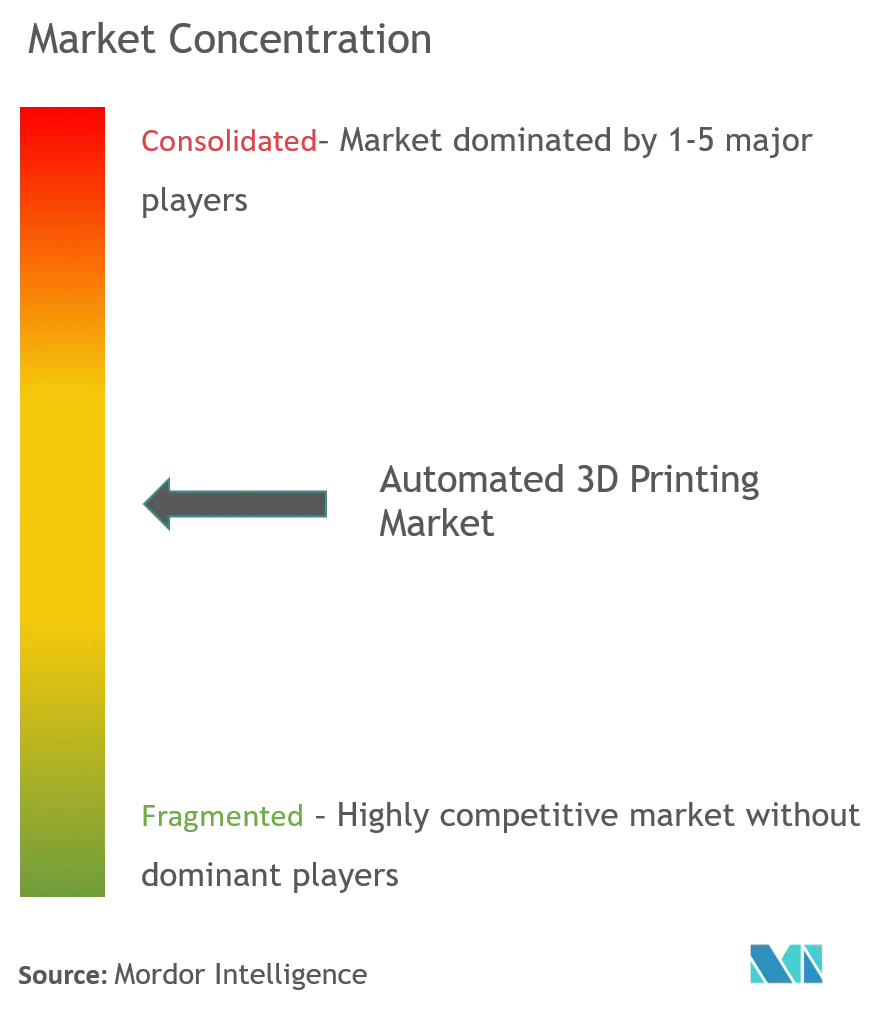
Recent Industry Developments
- June 2022 - Triditive, a Spanish company, nets EUR 5 million to boost 3D printing in the manufacturing sector. The company is focused on the development of industrial machinery and software which enables the automation of additive manufacturing to propel its industrial adoption.
- February 2022 - Universal Robots announced plans to expand to Ireland. The company will showcase its cobots on the Ireland Cobot Automation Tour 2022, set to take place between March 21 and 24, 2022. Visitors can get hands-on experience with cobots and hear directly from industry experts on optimizing production efficiency through automation.
- January 2022 - Authentise Inc. announced the acquisition of Elements Technology Platform, the provider of self-serve workflow tools for manufacturing. This will bring together a potent mix of technology and tools for workflow management, real-time machine data insight, RFID, AI, technologies, and more.
- September 2021 - The DLP system and EnvisionTEC partnered up with Polymer 3D printing specialist Covestro to provide a new material and printer combination for DLP tool applications. Both companies are accelerating the adoption of industrial 3D printing by lowering the barriers to entry for companies seeking to manufacture molds for small quantities or parts with more rapid and economically detailed features. To do this, they combined Covestro's material expertise with EnvisionTEC's 3D printer technology to create what they claim to be a complete industrial manufacturing product for 3D printing injection molding dies.
Global Automated 3D Printing Market Report Scope
The automated 3D printing market is segmented by offering (hardware, software, and services), process (automated production, material handling, part handling, post-processing, and multiprocessing), end user (industrial manufacturing, automotive, aerospace and defense, consumer products, healthcare, and energy), and geography.
Automated 3D printing refers to the application of technologies such as robotics arms or any other electronic systems to perform 3D printing tasks in environments that are either critical or tedious for human intervention, thereby end-users both monetary and operational efficiencies. The reports cover the emerging trends in automated 3D printing segmented by offering, process, and end-user verticals across different regions studied.
| Hardware |
| Software |
| Services |
| Automated Production |
| Material Handling |
| Part Handling |
| Post-Processing |
| Multiprocessing |
| Industrial Manufacturing |
| Automotive |
| Aerospace and Defense |
| Consumer Products |
| Healthcare |
| Energy |
| Other End-user Verticals |
| North America |
| Europe |
| Asia Pacific |
| Latin America |
| Middle-East and Africa |
| Offering | Hardware |
| Software | |
| Services | |
| Process | Automated Production |
| Material Handling | |
| Part Handling | |
| Post-Processing | |
| Multiprocessing | |
| End-user Vertical | Industrial Manufacturing |
| Automotive | |
| Aerospace and Defense | |
| Consumer Products | |
| Healthcare | |
| Energy | |
| Other End-user Verticals | |
| Geography | North America |
| Europe | |
| Asia Pacific | |
| Latin America | |
| Middle-East and Africa |
Key Questions Answered in the Report
How big is the Automated 3D Printing Market?
The Automated 3D Printing Market size is expected to reach USD 2.91 billion in 2025 and grow at a CAGR of 36.49% to reach USD 13.77 billion by 2030.
What is the current Automated 3D Printing Market size?
In 2025, the Automated 3D Printing Market size is expected to reach USD 2.91 billion.
Who are the key players in Automated 3D Printing Market?
Stratasys, Ltd., The ExOne Company, SLM Solutions Group AG, 3D Systems Corporation and Concept Laser Inc (GE Additive) are the major companies operating in the Automated 3D Printing Market.
Which is the fastest growing region in Automated 3D Printing Market?
Europe is estimated to grow at the highest CAGR over the forecast period (2025-2030).
Which region has the biggest share in Automated 3D Printing Market?
In 2025, the North America accounts for the largest market share in Automated 3D Printing Market.
What years does this Automated 3D Printing Market cover, and what was the market size in 2024?
In 2024, the Automated 3D Printing Market size was estimated at USD 1.85 billion. The report covers the Automated 3D Printing Market historical market size for years: 2019, 2020, 2021, 2022, 2023 and 2024. The report also forecasts the Automated 3D Printing Market size for years: 2025, 2026, 2027, 2028, 2029 and 2030.
Page last updated on:
